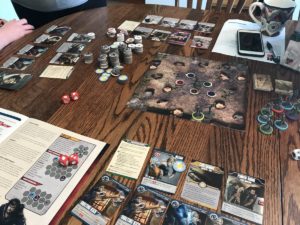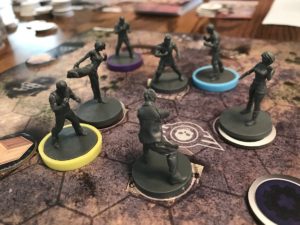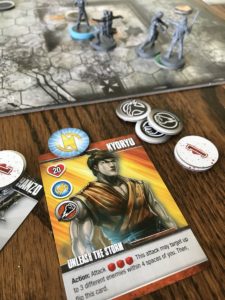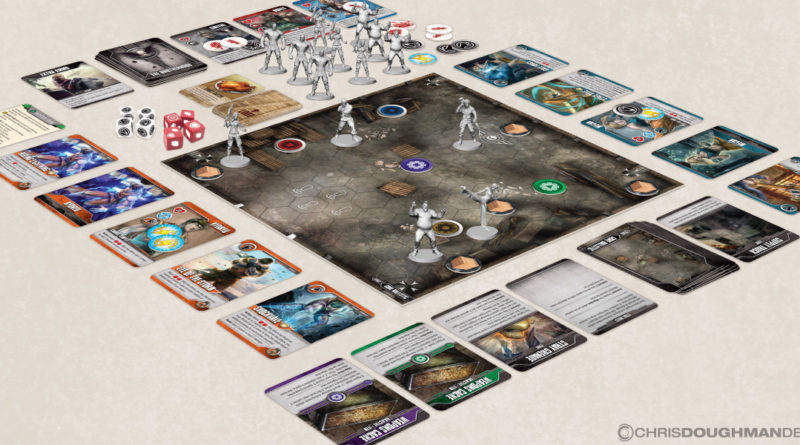Board Game Review: Street Masters: Rise of the Kingdom
I loved fighting games as a kid: Street Fighter, Clay Fighter, Soulcalibur. Without a video game system in the house other than a Game Boy, I would play them any chance I could at my friends’ houses or at Chuck E Cheese. Same goes with the TMNT and X-Men arcade games; those games sucked down all my quarters. So, when given the chance to review Street Masters: Rise of the Kingdom from Blacklist Games, I jumped at the chance. A co-op beat-’em-up as a miniatures board game? These are two great tastes that should taste great together.
Spoiler: They do.
This is the first of many reviews where I’ll be reviewing all of the Street Masters products released with the Kickstarter. Today we’re looking at the core box: Rise of the Kingdom.

The game has a very similar structure to Sentinels of the Multiverse. The players will each choose a Fighter deck (which contains all the info they need for their character) and a matching miniature. Then a Villain deck is chosen, making sure to pull out the miniatures of the boss and all the minions in the deck. Then the players will choose the Stage deck and the corresponding board. On each turn, each Fighter will act, then the Villain will act, then the Stage will act.
Players place their heroes on the board on top of the joystick icons (something I thought was very evocative), and place the villain on the skull icon. The minions all have colored rings placed on the minis to differentiate them and determine what cards affect which figure.
When it is your turn, you will draw from the Villain deck, placing any minion cards in the player’s threat area (essentially the area right in front of you on the table). By doing this, the minion actions are split up between the players, rather than having them all go at the same time during the Villain turn. The corresponding miniature (with a colored ring to match the color of the card) is placed on the map at the nearest spawn point. Then the player gets to act. You can do three things: move, play a card, or take an action (of which there are 4), so you essentially get to do three things each turn. One of your actions may be to move again, allowing you to sprint across the battlefield, or you can use an action on one of your cards (separate from playing a card). This allows you to create cool combos where you’ll attack one enemy with a card action, move to another enemy, play a card that allows you to cause damage to the new enemy, and then perhaps the text allows you to perform another kind of action. Those are the most satisfying turns, but they don’t begin appearing until later in the game once you have cards built up.

After you take your actions (while still your turn), any minions in your threat area act, following the rules on their card. If they’re long range, perhaps they’ll retreat from close combat with you and fire. If they’re close combat, they may move toward the nearest player to engage with them. Each villain feels unique in this way, acting autonomously.
After each player has taken their turns, the boss acts. Now, in our first game, we thought that all of the villain cards acted, but that’s not the case. Any minions in the players’ threat area only act on that player’s turn. The boss and all cards in the villain’s play area act. For one of the bosses, Juan, he reloads his shotgun if it is unloaded, or he fires off a few shots at nearby players if it is. Others may move in and attack multiple players at once. Each boss has a set of hit points you must overcome to win, which scales up per player. For a single player, they may only need to deal 20 damage, while with two, they now need to deal 40. Each player makes the villain that much more difficult to defeat.
The environment stage then acts. Each map (called a Stage) has unique mechanics and has specific lose conditions for the hero. In one, the environment cards will pull villains toward the objective tokens which are suitcases, then compel the villains to escape the board. If all cases are taken off the board, the players lose (leading to a mad scramble to snatch up the cases and keep them out of the hands of the villains), where in another, a series of cloning vats create new fighters each turn. They’re all really unique and definitely put you into the heat of the situation. One scenario has the players coming under constant fire. If you don’t end your turn in cover, you will continue to get shot at, so players will spread out, ducking behind barrels and crates to keep themselves safe.

Players and villains can build up defensive tokens during the game, discarding them to ignore damage. For villains, those tokens are simply discarded, but for players, they flip the tokens to turn them into Charge tokens. Once a fighter has built up enough charge (indicated on their character card), the player flips the card, creating an overcharged version of the hero who can unleash a special power before flipping back over to the standard side. It’s really iconic and feels amazing when you get to flip it over.
The game also contains Ally and Rival cards for your game. If the game is feeling too difficult? You can take one of the villain models and make it an Ally, with a unique card you place in your own player area to act side-by-side with you. If you’re looking for a more difficult challenge, you can flip that Ally card and play them as a Rival, where they’ll act like an additional enemy on the board against you. It adds a little flavor, and helps you get through some of those more difficult stages.
I really, really like this game. Sitting down to play feels like I’m playing an arcade game as swarms of enemies attack me while I punch and kick my way to victory. The rules are simple and straightforward, then are modified by the cards played, which I really like; Introduce simple rules and allow other components to the game to add complexity to it. The miniatures are all gorgeous, the cards are evocative and the boards are all detailed and really well done.
If I had one criticism, it would be that I wish the rulebook had a page giving a brief description explaining the general “theme” of each deck. How does the deck work, what are its focuses? “This deck charges up and expends those charges for more power,” things like that. Also, I wish there was a “difficulty level” for each villain and stage so I could pick and choose how difficult a game will be. As it is, I have to play a stage a few times to determine if the stage is really that hard, or if I’m just playing poorly. I’d rather know from the start that I’m going into a harder game session. I’m going to do a breakdown of all fighters once I’m done with all my reviews to explain each one.
I haven’t covered story mode here, where you actually move through a whole storyline, setting up the villains and stages as the game determines, and where the things you do in the game affect what allies and rivals you gain, but I haven’t tried it yet. That will be for a later date.
Again, I really liked this game. I’ll be reviewing all of the expansions soon, so keep an eye out for those. There’s going to be a Kickstarter this fall so that people can get in and pick up the game who missed the last Kickstarter, and from what I hear, limited copies will be available at GenCon.

